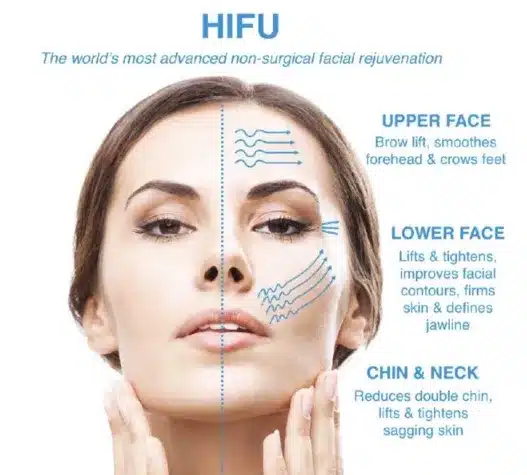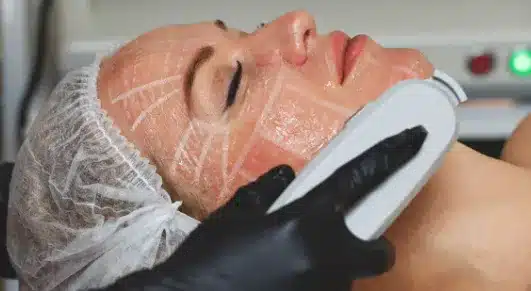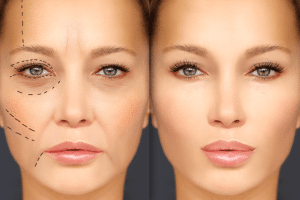HIFU facelift, a revolutionary cosmetic procedure, offers a non-invasive solution for individuals seeking facial rejuvenation. By utilizing high-intensity focused ultrasound (HIFU) technology, it effectively tightens the skin and stimulates collagen production, providing a natural-looking facelift without the need for surgery or extensive downtime. This innovative approach addresses sagging skin and wrinkles, yielding firmer, more youthful-looking results.
What is HIFU Facelift?
The desire for youthful and vibrant skin has led to the development of various cosmetic procedures. One such innovative technique is High-Intensity Focused Ultrasound (HIFU) facelift. HIFU facelift has become a non-invasive and non-surgical treatment option for skin rejuvenation, offering noticeable results without incisions or downtime. In this article, we will delve into the details of the HIFU facelift, explaining how it works, who can benefit from it, its benefits and risks, the process involved, and the essential before and aftercare steps.
Cosmetic Face surgery, also known as facial plastic surgery, encompasses a range of procedures designed to enhance and rejuvenate various areas of the face. Whether you’re looking to reverse signs of aging or reshape specific features, face surgery offers numerous options to achieve your desired aesthetic goals.
HIFU facelift, also known as ultrasound facelift or Ul therapy, is a cosmetic procedure that uses focused ultrasound energy to lift, tone, and tighten the skin on the face, neck, and décolletage. This non-invasive treatment stimulates collagen production deep within the layers of the skin, resulting in a firming and lifting effect.
How Does HIFU Facelift Work? Step-by-Step Process
- Consultation: The process begins with a qualified aesthetic specialist who will assess your skin and discuss your goals and expectations.
- Cleansing: The treatment area is thoroughly cleansed to remove any traces of makeup, oils, or impurities.
- Targeted Ultrasound Energy: The HIFU device delivers precise and focused ultrasound energy to specific depths within the skin layers. This energy triggers a thermal response, stimulating collagen production and tissue rejuvenation.
- Sensation and Monitoring: During the procedure, you may experience mild discomfort or a warm sensation, which indicates that the ultrasound energy is penetrating the skin. The aesthetic specialist will closely monitor the treatment process to ensure optimal results.
- Duration: The duration of the procedure varies depending on the treated areas and desired results, but it typically takes between 30 to 90 minutes.
- Immediate and Progressive Results: Some immediate lifting and tightening effects may be noticeable, but the full results develop gradually over several weeks as collagen production continues to improve the skin’s appearance.
Clinic contact number: +989371200167
The Rise of HIFU in Aesthetic Medicine
High-Intensity Focused Ultrasound (HIFU) facelift has emerged as a leading non-invasive aesthetic procedure, leveraging ultrasound energy to target the layers of skin just below the surface, stimulating collagen production and resulting in a firmer, more youthful complexion.
Among the vanguards of research in this field, institutions like Stanford University and Harvard Medical School standout, having contributed significantly to the advancement and understanding of HIFU technology. Esteemed professionals such as Dr. Michael H. Slayton and Dr. Feng Wu have been pivotal, publishing extensive research that delves into the mechanics of HIFU and its application in dermatology and aesthetic medicine, thereby solidifying the scientific foundation upon which HIFU facelift procedures are based.
The most active entity in the HIFU facelift sector is arguably Ul therapy, a company whose technology is specifically designed for non-invasive lifting and tightening of the skin on the face, neck, and décolletage. Ul therapy’s devices are renowned for their precision and effectiveness, making them a preferred choice among dermatology clinics worldwide. Recent statistics highlight the burgeoning demand for HIFU facelifts, with the global market for non-invasive aesthetic treatments expected to grow significantly.
The number of HIFU treatments has seen a yearly increase, with thousands of procedures now being performed globally. This surge is a testament to the efficacy and safety profile of HIFU technology, which, coupled with continuous innovations and refinements in technique, underscores its pivotal role in the future of cosmetic dermatology and non-surgical facial rejuvenation.

Who Can Get HIFU Facelift?
HIFU facelift is suitable for individuals who want to address mild to moderate signs of skin aging, such as sagging skin, fine lines, and wrinkles. It is generally recommended for people aged 30 and above, although individual eligibility can be determined during the consultation process. People with severe skin laxity or those seeking more dramatic results may require alternative treatment options, such as surgical facelifts.
HIFU for face cost
High-Intensity Focused Ultrasound (HIFU) is a non-invasive cosmetic procedure used to lift and tighten the skin on the face and neck by stimulating collagen production. The cost of HIFU for the face can vary depending on several factors, including the geographic location of the treatment facility, the reputation and expertise of the provider, the specific areas being treated, and the number of sessions required to achieve desired results. On average, the cost of a single HIFU treatment for the face can range from $1,000 to $3,000. However, this estimate may not include additional fees such as consultation fees, anesthesia fees, or post-treatment skincare products.
In addition to the direct costs of the procedure, patients should also consider the potential value and benefits of HIFU treatment when evaluating the overall cost. HIFU offers a non-invasive alternative to surgical facelift procedures, with minimal downtime and fewer risks of complications. While the initial cost of HIFU treatment may be higher than some other non-invasive procedures, such as injectables or laser treatments, the long-term benefits and natural-looking results may justify the investment for many patients. It’s essential for individuals considering HIFU treatment to consult with a qualified provider to discuss their goals, concerns, and treatment options, as well as to obtain a personalized cost estimate based on their individual needs and desired outcomes.

7 Benefits of HIFU Facelift
- Non-Invasive: HIFU lift is a non-invasive procedure that does not require incisions, resulting in minimal discomfort and no scarring.
- Stimulates Collagen Production: By stimulating collagen production, the HIFU facelift improves skin elasticity, resulting in a more youthful and lifted appearance.
- Natural-Looking Results: The gradual improvement in the skin’s appearance achieved through his non-surgical treatment provides natural-looking results, avoiding an overly drastic change.
- No Downtime: Unlike surgical facelifts, his non-surgical treatment does not require extensive recovery time. Patients can resume their daily activities immediately after the procedure.
Facial contouring surgery, also known as facial sculpting or facial reshaping, is a cosmetic procedure aimed at enhancing the facial structure and achieving a more balanced, harmonious appearance. This surgical technique involves altering certain facial features’ shape, size, or position to create a more aesthetically pleasing look.
- Versatile Treatment Areas: this non-surgical treatment can be performed on various areas, including the face, neck, and décolletage, allowing for comprehensive skin rejuvenation.
- Long-Lasting Results: The effects of HIFU facelifts can last up to 1-2 years, depending on individual factors and the quality of aftercare.
- Minimal Side Effects: HIFU facelift is generally well-tolerated, with minimal side effects, such as temporary redness, swelling, or tingling, which usually subside within a few hours.
Clinic contact number: +989371200167
7 Risks of HIFU Facelift
- Temporary Discomfort: Some individuals may experience mild discomfort during the procedure, which can be managed with pain medication or numbing creams.
- Transient Side Effects: Temporary redness, swelling, or tingling in the treated areas may occur but typically resolve within a short period.
- Rare Adverse Reactions: Although rare, potential adverse reactions may include bruising, numbness, or skin burns. These complications are uncommon when the procedure is performed by a trained professional.
- Limited Efficacy on Severe Laxity: lifts may not provide optimal results for individuals with significant skin laxity or deep wrinkles. Surgical options may be more appropriate in such cases.
- Treatment Frequency: While HIFU facelift provides long-lasting results, maintenance sessions may be required after the initial treatment to sustain the effects.
- Individual Variations: The results of HIFU facelifts can vary based on individual factors such as skin type, age, overall health, and lifestyle choices.
- Treatment Limitations: his non-surgical treatment primarily targets the deep layers of the skin and may have limited effects on surface irregularities, such as pigmentation or texture.

Some people report mild discomfort during the treatment, and some have pain afterward. Doctors may apply a local anesthetic before the procedure to help prevent this pain. Over-the-counter pain relievers, such as acetaminophen (Tylenol) or ibuprofen (Advil), may also help. Medical News Today
What is Involved in HIFU Facelift?
HIFU facelift typically involves the following steps:
- Consultation with an aesthetic specialist to assess eligibility and discuss expectations.
- Cleansing of the treatment area.
- Targeted delivery of ultrasound energy to specific depths within the skin layers.
- Monitoring of the treatment process to ensure optimal results.
- Completion of the procedure, which can take between 30 to 90 minutes, depending on the treatment areas.
HIFU for face procedure
High-Intensity Focused Ultrasound (HIFU) for the face is a non-invasive cosmetic procedure that uses ultrasound energy to lift and tighten the skin. During the HIFU procedure, a handheld device delivers focused ultrasound energy deep into the skin’s layers, targeting the foundational tissues responsible for supporting the skin’s structure. This energy stimulates the production of collagen, a protein that helps improve skin elasticity and firmness. As collagen production increases, the skin gradually becomes tighter and more lifted, resulting in a rejuvenated and youthful appearance.
One of the key advantages of HIFU for the face is its ability to provide noticeable results without the need for surgery or downtime. Unlike traditional facelift procedures, which involve incisions and tissue manipulation, HIFU treatment is non-invasive and typically requires no anesthesia or sedation. Most patients experience minimal discomfort during the procedure, with some temporary redness or mild swelling immediately afterward. Because HIFU targets deep layers of the skin without affecting the surface, there is no damage to the outer skin layer, allowing patients to resume their normal activities immediately following treatment.
HIFU treatment for the face is suitable for individuals with mild to moderate skin laxity who are seeking a non-surgical option for facial rejuvenation. It can effectively lift and tighten the skin on the cheeks, jawline, chin, and neck, reducing the appearance of sagging and wrinkles. While HIFU results may not be as dramatic or long-lasting as those achieved with surgical facelift procedures, many patients appreciate the natural-looking improvements and minimal downtime associated with HIFU treatment. Multiple sessions may be recommended to achieve optimal results, with noticeable improvements typically seen within a few months of treatment.

What other treatments does it work well with?
HIFU treatment for the face can complement other non-invasive cosmetic procedures to enhance overall facial rejuvenation and address multiple concerns simultaneously. One common combination is pairing HIFU with injectable dermal fillers or neuromodulators such as Botox. While HIFU targets skin laxity and promotes collagen production, dermal fillers can add volume to areas of the face affected by volume loss, such as the cheeks or under-eye area. Additionally, neuromodulators can help relax dynamic wrinkles caused by repetitive facial movements, such as crow’s feet or forehead lines, further enhancing the results of HIFU treatment.
Moreover, HIFU can be used in conjunction with skin resurfacing treatments like laser therapy or chemical peels to improve overall skin texture and tone. These treatments can address concerns such as fine lines, uneven pigmentation, and skin irregularities, while HIFU targets deeper tissues for lifting and tightening. Combining HIFU with skin resurfacing procedures can provide comprehensive facial rejuvenation, addressing both structural and superficial aspects of aging for more noticeable and long-lasting results. However, the specific combination of treatments will depend on individual needs and goals, and it’s essential to consult with a qualified cosmetic provider to develop a personalized treatment plan.
Before and Aftercare of HIFU Facelift
To maximize the results and ensure a smooth recovery, it is important to follow these essential before and aftercare steps for the HIFU lift:
Before the Treatment
Before undergoing a High-Intensity Focused Ultrasound (HIFU) facelift treatment, it’s essential to understand what it entails and to consider several factors:
Research and Consultation
Make sure you thoroughly research HIFU facelift procedures, understand how they work, their potential benefits, and risks. Schedule a consultation with a qualified dermatologist or cosmetic surgeon who specializes in HIFU treatments to discuss your goals, expectations, and any concerns you may have.
Health Assessment
Your healthcare provider will assess your overall health and medical history to determine if you’re a suitable candidate for the procedure. Inform them about any existing medical conditions, allergies, medications you’re taking, or previous cosmetic procedures you’ve undergone.
Realistic Expectations
Understand that while HIFU facelifts can provide noticeable improvements in skin laxity and facial contours, they may not deliver the same results as surgical facelifts. Manage your expectations and discuss realistic outcomes with your healthcare provider.
After the Treatment
After undergoing a High-Intensity Focused Ultrasound (HIFU) facelift treatment, it’s important to follow specific post-treatment guidelines to ensure optimal results and minimize any potential side effects. Here’s what you can expect and how to care for your skin after the procedure:
Immediate Effects
You may experience some immediate effects after the treatment, such as mild redness, swelling, or tingling sensation. These effects are usually temporary and should subside within a few hours to a few days.
Recovery Period
While HIFU is a non-invasive procedure, your skin may need some time to recover fully. Allow yourself a few days of rest, and avoid strenuous activities, excessive sun exposure, and heat exposure (like saunas or hot baths) during this time.
Skincare Routine
Follow any specific skincare recommendations provided by your healthcare provider. They may advise you to use gentle cleansers, moisturizers, and sunscreen to protect your skin and promote healing.
Benefits of high-intensity focused ultrasound
According to the American Society for Aesthetic Plastic Surgery (ASAPS), HIFU and other nonsurgical alternatives to facelifts have seen a major increase in popularity over the last few years. The total number of procedures performed has increased 64.8 percent between 2012 and 2017.
HIFU has many aesthetic benefits, including:
wrinkle reduction.
tightening sagging skin on the neck (sometimes called turkey neck)
lifting the cheeks, eyebrows, and eyelids
enhancing jawline definition
tightening of the décolletage
smoothing the skin
Study results are promising. A 2017 study Trusted Source involving 32 Korean people showed that HIFU significantly improved skin elasticity of the cheeks, lower abdomen, and thighs after 12 weeks.
In a larger study of 93 people, 66 percent of those treated with HIFU perceived an improvement in the appearance of their face and neck after 90 days.
Clinic contact number: +989371200167
Summary
When considering cosmetic procedures like a brow lift or eyelid surgery, it’s essential to weigh the benefits of each option. For those preferring a non-invasive approach, HIFU (High-Intensity Focused Ultrasound) technology offers a compelling solution. With its ability to tighten the skin and stimulate collagen production using ultrasonic waves, HIFU provides a safe and effective alternative to traditional surgical methods. Moreover, this advanced technique ensures long-lasting results without the need for incisions or significant downtime, making it an appealing choice for individuals seeking facial rejuvenation with minimal intervention.
While a brow lift and eyelid surgery may offer more immediate and dramatic outcomes, they typically involve invasive procedures that carry inherent risks. In contrast, HIFU treatments prioritize patient safety and comfort, delivering gradual yet noticeable improvements in skin laxity and appearance. Ultimately, the decision between a brow lift or eyelid surgery versus HIFU facelift depends on individual preferences, desired outcomes, and tolerance for invasiveness, with HIFU standing out as a non-invasive option that prioritizes skin tightening, collagen production, and enduring results.

FAQs
1. How long do the results of the HIFU facelift last?
The results of a HIFU facelift can last up to 1-2 years, depending on individual factors such as age, lifestyle, and skincare routine. Maintenance sessions may be recommended to sustain the effects over time.
2. Is the HIFU facelift suitable for everyone?
HIFU facelift is generally suitable for individuals aged 30 and above who have mild to moderate signs of skin aging. However, individual eligibility can be determined during a consultation with an aesthetic specialist.
3. What is HIFU facelift?
HIFU facelift, or High-Intensity Focused Ultrasound facelift, is a non-surgical cosmetic procedure designed to lift and tighten the skin on the face and neck using ultrasound energy. Unlike traditional facelift surgery, which involves incisions and tissue manipulation, HIFU facelift utilizes focused ultrasound waves to stimulate collagen production deep within the skin’s layers. This process helps improve skin elasticity and firmness, resulting in a lifted and rejuvenated appearance without the need for surgery or downtime.
4. How does HIFU facelift work?
During a HIFU facelift procedure, a handheld device delivers precise ultrasound energy to targeted areas of the face and neck, such as the forehead, cheeks, jawline, and neck. The ultrasound waves penetrate deep into the skin’s layers, targeting the foundational tissues responsible for supporting the skin’s structure. This energy stimulates the production of collagen, a protein that helps improve skin elasticity and firmness over time. As collagen production increases, the skin gradually becomes tighter and more lifted, reducing the appearance of sagging and wrinkles. HIFU facelift is a non-invasive treatment that typically requires no anesthesia or sedation, and most patients can resume their normal activities immediately following the procedure.
5. What are the benefits of HIFU facelift compared to traditional surgical facelift?
HIFU facelift offers several advantages over traditional surgical facelift procedures. Firstly, HIFU facelift is non-invasive, meaning it does not involve incisions or tissue manipulation, resulting in minimal discomfort, downtime, and risk of complications. Additionally, HIFU facelift stimulates natural collagen production, leading to gradual and natural-looking results without the “pulled” or “tightened” appearance often associated with surgical facelifts. Furthermore, HIFU facelift allows for targeted treatment of specific areas of concern, such as the forehead, cheeks, jawline, and neck, providing customizable results tailored to each patient’s individual needs and goals.
HIFU facial: What is it, how it works, effects, cost, and more (medicalnewstoday.com)
https://www.healthline.com/health/hifu-for-face#benefits



